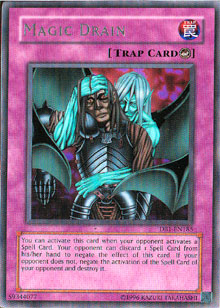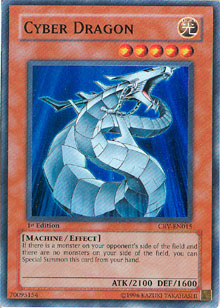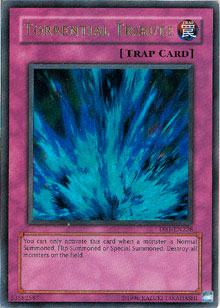As you can see from the results of Shonen Jump Championship Columbus, the environment seems to have shifted. In most cases, you can lose a game in a single big turn, with decks spurred by one-turn KO catalysts such as Dimension Fusion, Return from the Different Dimension, and Advanced Ritual Art.
Many of the top-tier deck themes that revolve around these types of combos have a few weaknesses linking them together. I want to spend the next several articles discussing strategies that unite these decks and how to exploit them.
Any time you’re trying to tech against a format, it’s important to remember that single-minded objectives are not always good. Cards that may help in a certain matchup (such as Monarchs) but fail against the others will generally exclude you from Day 2. Any choice you make for a deck should be versatile enough to swing certain matchups in your favor, without being a liability in other cases. Also remember that a good side deck should make even the bad cards in your deck better for games 2 and 3 at least.
Honing in on a Weakness of Top Level Decks in the Environment
 Both Diamond Dude Turbo and the Advanced Ritual Art deck are one-turn KO combo builds designed to take out the opponent in one explosive turn. They’re not one-trick ponies by any stretch of the imagination and can win without the original win condition, but one-turn KO is what they’re designed to do.
Both Diamond Dude Turbo and the Advanced Ritual Art deck are one-turn KO combo builds designed to take out the opponent in one explosive turn. They’re not one-trick ponies by any stretch of the imagination and can win without the original win condition, but one-turn KO is what they’re designed to do.
The Destiny Hero build aims to use a combination of Monster Gate and Reasoning to send monsters into the graveyard. This will often result in a big monster such as Jinzo or Dark Magician of Chaos. The rest of the monsters in the graveyard are removed from play through Divine Sword - Phoenix Blade, Dimension Fusion is activated, and finally, Lightning Vortex clears the opponent’s field. Pretty simple, right?
As you can see, this requires a lot of spell cards to function. If you can stop the chain of events at even one key point, it leaves the deck with severe field stability issues, considering that the deck only runs twelve or so monsters.
The Advanced Ritual Art build is obviously based around the spell card of the same name. It aims to slow the game down, and then summon Demise, King of Armageddon, using his effect to wipe the field clean. Assuming Demise remains on the field, cards like Premature Burial, The Rock Spirit, Doom Dozer, and Megamorph aim to finish the game in that single turn.
Once again, you can see that the deck packs an inordinate number of spells. You’ll need to successfully activate the Ritual spell, and then usually you’ll need either Megamorph, Premature Burial, or both in hand to seal the deal. Cutting the opponent’s supply of spell cards grinds the deck to a halt.
 Enter Magic Drain, a counter-trap that’s designed to disrupt combo-heavy builds such as Diamond Dude Turbo and Advanced Ritual Art.
Enter Magic Drain, a counter-trap that’s designed to disrupt combo-heavy builds such as Diamond Dude Turbo and Advanced Ritual Art.
The Power of Undermining an Opponent’s Strategy
Magic Drain doesn’t entirely negate the opponent’s strategy. He or she can still discard a precious spell card in hand to get the original one’s effect through. However, such disruption comes at a steeper cost to your opponent than it does to you. Assuming you have the field presence to back up the threat of your disruption (we’ll get into monster builds later), a card like Magic Drain can go a long way towards stopping cards like Dimension Fusion and Advanced Ritual Art.
Combo-based decks struggle more from hand disruption than more generic aggressive strategies. Using Confiscation against a player banking on a home run threat such as Dimension Fusion will generally hurt a lot more than robbing a slower deck of cards like Sakuretsu Armor and Mystical Space Typhoon. Keep that in mind when devising counters.
Constructing the Monster Lineup of the Counter-Trap Build
Usually the biggest threat to both of these builds is the potential for a Mystic Tomato to trade with either Diamond Dude or one of the Ritual helpers. In that situation, both monsters will be destroyed, but the controller of Tomato will get to special summon another (particularly damaging if the new monster is Spirit Reaper or Don Zaloog). Therefore, we’re going to pack three copies of Mystic Tomato along with a few other self-replacing searchers that should lead to ruthless aggression.
Field Presence Stabilizers (and what they can search for):
3 Cyber Dragon
3 Mystic Tomato
3 Giant Rat
1 Neo-Spacian Grand Mole
2 Exiled Force
2 Injection Fairy Lily
1 Spirit Reaper
1 Don Zaloog
1 Sangan
1 Treeborn Frog
 This lineup looks extremely solid. We have six recruiters that can attack into the different recruiters that Advanced Ritual Art loves to play. None of the six lose field presence through battle, and all of them can lead into huge threats that definitely impact the play of the duel.
This lineup looks extremely solid. We have six recruiters that can attack into the different recruiters that Advanced Ritual Art loves to play. None of the six lose field presence through battle, and all of them can lead into huge threats that definitely impact the play of the duel.
Running three copies of Cyber Dragon is perfect, due to its field swarm capabilities. The other touches add different abilities to the deck, but we’re talking about powerhouse material here. A special note is Lily, the 800 pound gorilla of your deck. Two direct hits and the opponent will be unable to play Demise or Dimension Fusion.
We’ll throw in two copies of Mask of Darkness and two copies of Zaborg the Thunder Monarch to round out the list.
Constructing the Spell Lineup of the Counter-Trap Build
We can certainly include six of the more commonly used spell cards. All of them will serve our purposes, and of the six, only Nobleman of Crossout should be consistently sided out.
1 Snatch Steal
1 Nobleman of Crossout
1 Heavy Storm
1 Mystical Space Typhoon
1 Premature Burial
Let’s throw in a few solid spell cards.
1 Book of Moon: Book of Moon is one of the few defensive cards we’ll run in this deck, mainly because it can also act as an enabler on the attack. With such small monsters in general, we may need its services.
2 Smashing Ground: Again, the presence of some lower ATK monsters necessitates the use of this card.
1 Creature Swap: While this deck does indeed pack too much synergy with Creature Swap to ignore its inclusion, two copies would be a bit unstable.
Constructing the Trap Lineup of the Counter-Trap Build
 We can include most of the commonly played traps. However, let’s remove Call of the Haunted. Its uses are more limited here, and the lack of tribute monsters and the presence of many monsters with low ATK make it a difficult candidate for inclusion.
We can include most of the commonly played traps. However, let’s remove Call of the Haunted. Its uses are more limited here, and the lack of tribute monsters and the presence of many monsters with low ATK make it a difficult candidate for inclusion.
1 Torrential Tribute
1 Ring of Destruction
1 Mirror Force
As for the rest of the traps, they’ll look something like this. We have about five to seven slots to play with.
3 Magic Drain: This counter-trap is the very reason we built the deck. It should definitely help us dominate a few matchups.
2 Dust Tornado: Clearing the backfield is key, and having Magic Drain to support it against Heavy Storm makes Dust Tornado a no-brainer.
2 Solemn Judgment: Probably the most versatile counter-trap of all, Solemn Judgment benefits from great synergy with Mask of Darkness.
Expected Matchups with the Best Decks in the Format
Magic Drain is a wonderful example of tech because it’s not anywhere near useless in the event of a matchup it wasn’t intended for (such as Monarchs). It still packs surprisingly good utility in those games.
However, the deck really shines against Diamond Dude Turbo and Advanced Ritual Art decks. In a few playtesting games, the combination of a Mystic Tomato accompanied by Dust Tornado was too powerful for Advanced Ritual Art players to avoid, since they always summon Senju of the Thousand Hands, Manju of the Ten Thousand Hands, or Sonic Bird in attack position, with little to no defense.
Making such a trade and then special summoning Spirit Reaper is a big bonus of playing this deck. Once the groundwork of an effective offense is established, cards like Solemn Judgment and Magic Drain entirely negate anything the opponent can muster after that.
Instead of focusing on what you’re trying to do, try to anticipate the opponent’s deck and then work against its strategies. Often, by disrupting what your opponent takes for granted, you can scoop up huge wins with relative ease.